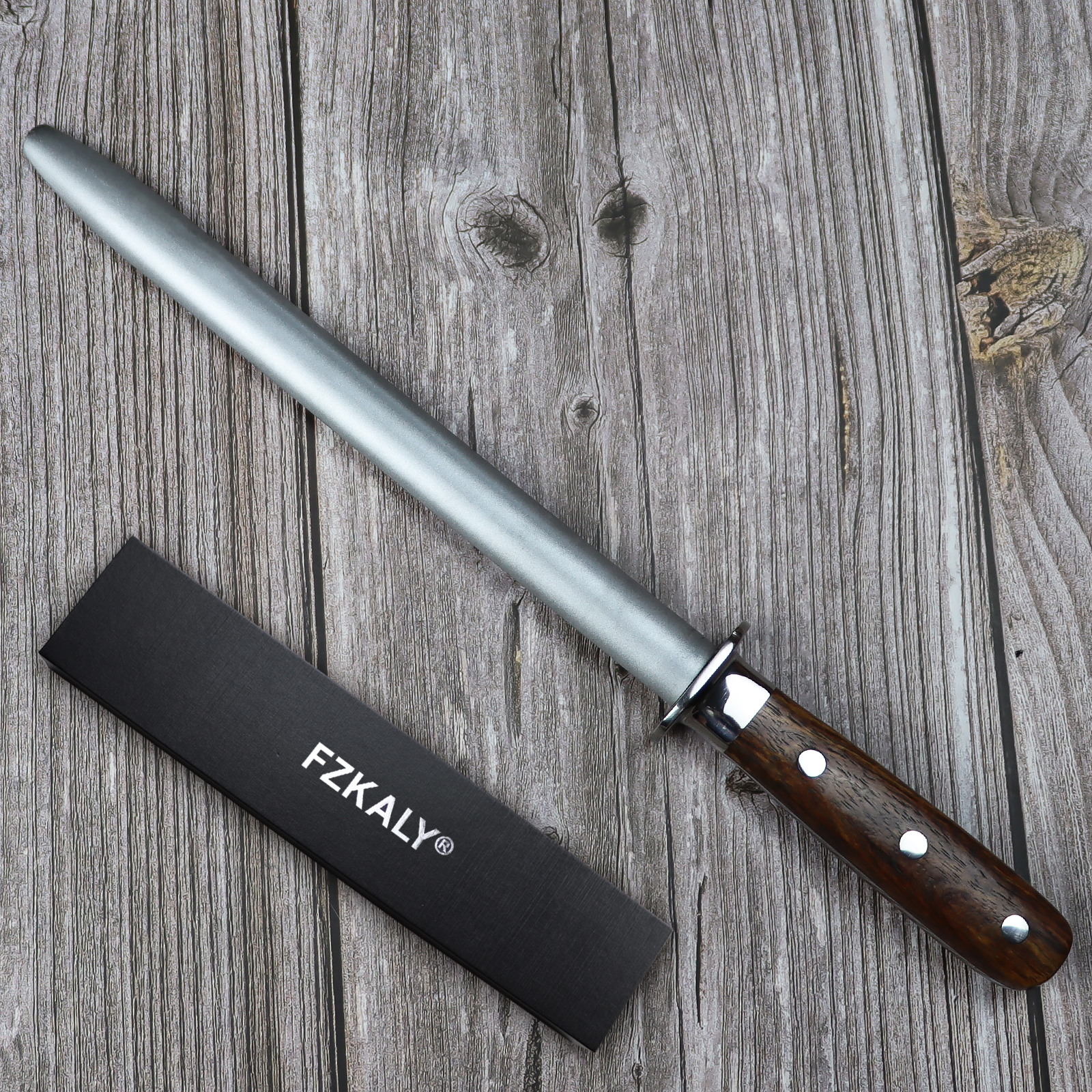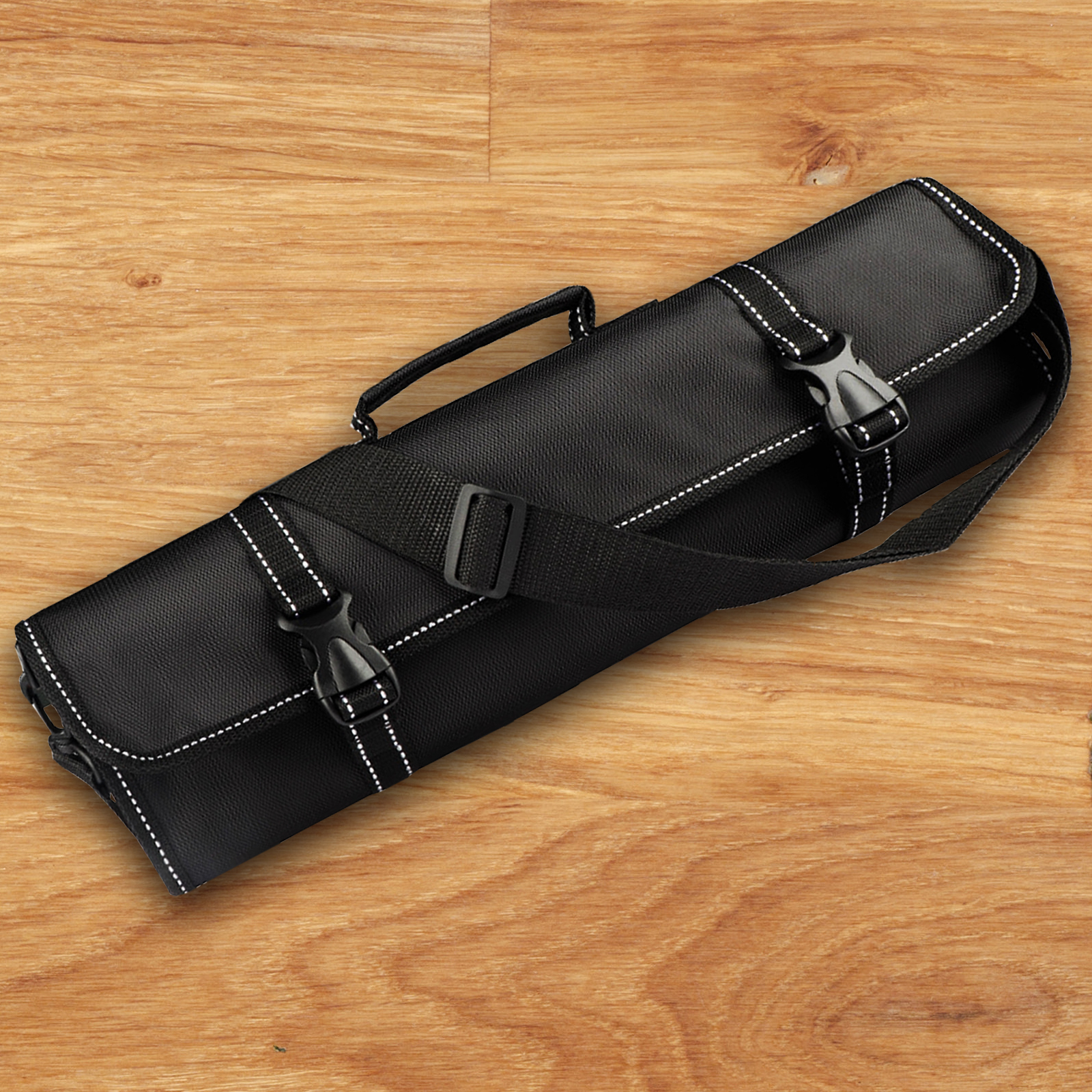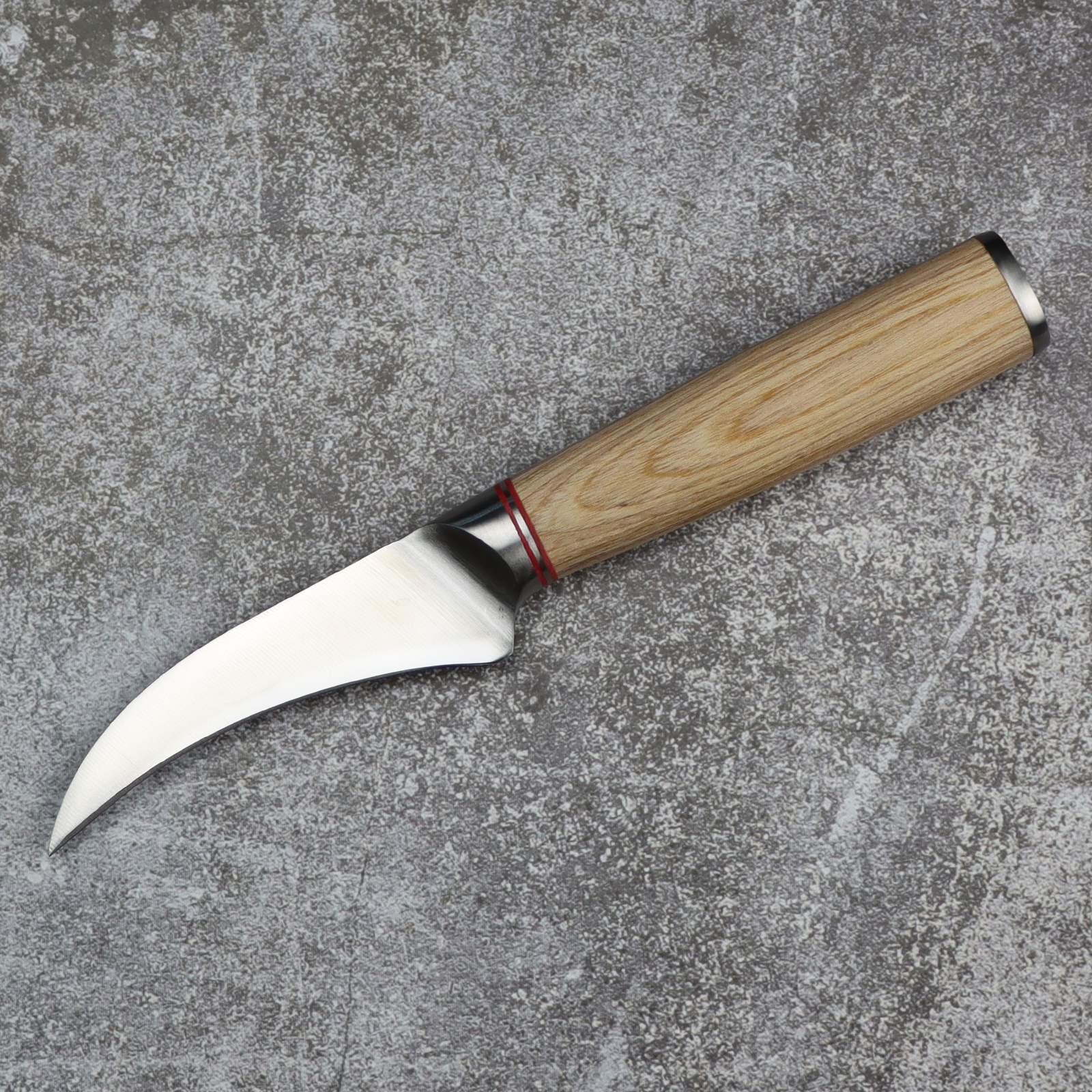How to Sharpen a Serrated Knife
Feb 17,2023 | Fzkaly
Don't be fooled by their jagged edges - serrated knives can and should be sharpened. While it's true that they don't require sharpening as often as straight-edge knives, neglecting to sharpen them can lead to dullness and reduced cutting performance.
Say goodbye to the frustration of trying to sharpen your serrated knife on your own. Our guide is the solution you've been looking for. Read on, with our easy-to-follow instructions and tips, you'll be able to sharpen your serrated knives with confidence and precision.
Before we start, let's take a look at the methods that can be used to sharpen serrated knives.
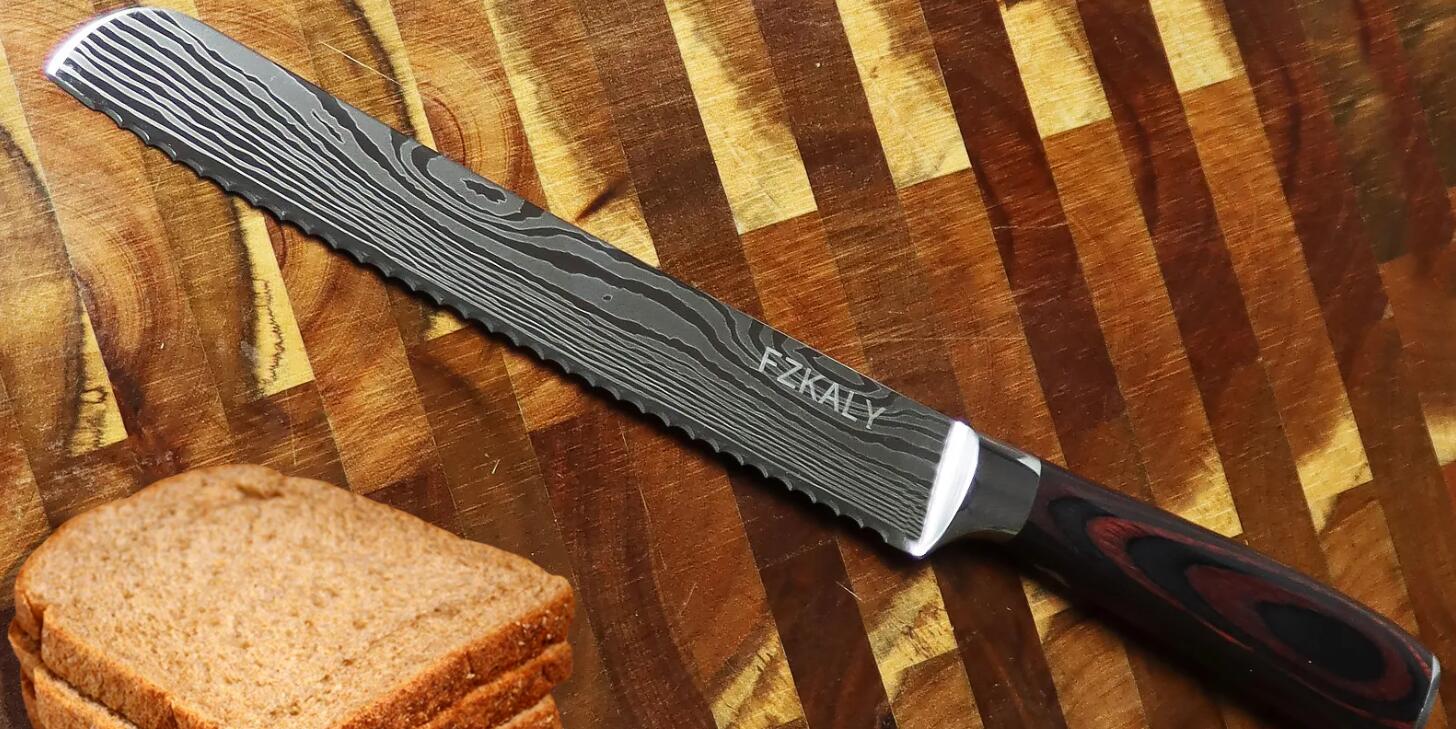
What methods can be used to sharpen serrated knives?
There are several methods you can use to sharpen a serrated knife, depending on your preference and the tools you have on hand. Here are a few:
Sharpening rod
A sharpening rod is a long, narrow tool with a tapered end. Choose a section of the rod that best fits the serrations of your knife and drag it across each serration a few times, making sure to keep the rod flush with the bevel of the blade.
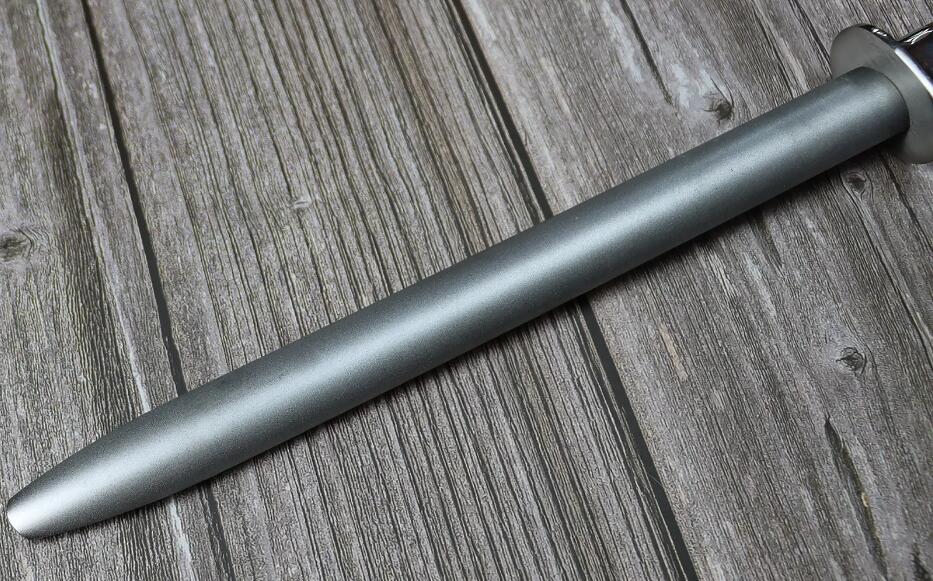
Manual sharpening
A serrated knife can be sharpened manually by using a sharpening stone or sandpaper. This method requires a bit more time and effort, but it can be effective.
Ceramic sharpening tool
A ceramic sharpening tool is a handheld device that has a tapered end and a row of ceramic ridges. You can run the ceramic tool along the serrations of the knife to sharpen them.
Diamond sharpening tool
Similar to a ceramic sharpening tool, a diamond sharpening tool has diamond ridges on the tapered end. This tool can be used to sharpen serrated knives as well.
Electric sharpeners
Some electric sharpeners come with a special slot for serrated knives, allowing you to sharpen them easily and quickly. However, not all electric sharpeners are suitable for serrated knives. While deluxe electric sharpeners can be effective in sharpening serrated knives, they may not be able to reach the entire surface of the concave gullets. This is because these sharpeners use sharpening surfaces that are mounted on spring-action bars, which can conform to the shape and angle of a serrated blade. However, even the best electric knife sharpener cannot fully automate the sharpening process for a serrated knife. This is why a manual approach using specialized tools can give you better results.
Free sharpening services
Check your knife's warranty to see if the manufacturer offers free sharpening services for serrated knives. If they do, simply send it back to them.
Professional sharpening service
Consider taking your serrated knife to a professional knife sharpener. While some places may not offer sharpening services for serrated knives, many do.
If you eventually decide to sharpen your serrated knife by yourself, we recommend using a sharpening stick for the job. and we'll tell you how to do it.
How to use a sharpening rod to sharpen a serrated knife?
Using a sharpening rod to sharpen a serrated knife can be a bit tricky, but it is an effective way to maintain the blade's sharpness. Here's how to do it:
First, select a sharpening rod that matches the size of the serrations on your knife. It's essential to use a rod that is small enough to fit into the serrations.
Hold the sharpening rod in one hand and the serrated knife in the other. Make sure the rod is at a similar angle to the serrations on the knife.
Start at the tip of the serrated blade, and insert the sharpening rod into the first serration. Place the rod against the inside edge of the serration.
Gently pull the rod towards you, moving it along the length of the serration. Make sure to keep the angle consistent as you move the rod through the serration.
Repeat the process with each serration until you have gone through all of them.
Once you have sharpened each serration, flip the knife over and repeat the process on the other side.
After sharpening, use a honing steel to align the serrations and remove any burrs that may have formed on the edge of the blade.
If your knife has 30 or more serrations, this process will take a little while. Once you're done, flip the knife over and give the flat side of the blade a few strokes on a regular sharpening stone or a piece of fine-grit sandpaper to smooth out the burr that you've raised on the edge of the knife. Finally, wash and dry the knife as usual, and you're all set.
4 Tips for sharpening serrated knives
1. Choose a serrated knife with fewer serrations
It is easier to sharpen and can be a better cutting tool in certain instances. When you slice with a serrated knife, you concentrate force into each serration, so the fewer serrations there are, the more forcefully they can cut into the food.
2. Sharpen your serrated knife only when necessary
Serrated knives are designed so that most of the tool doesn't make contact with the cutting board, so you don't need to sharpen it as often as other kitchen knives. Only sharpen your serrated knife when you notice it's getting dull. If you use your serrated knife infrequently, it may only require sharpening every few years.
3. Use the bread test
If you're unsure whether your serrated knife requires sharpening, pay attention the next time you use it to cut bread. If you generate a lot of crumbs, it wasn't a clean cut, and you should consider sharpening the knife.
4. Watch your fingers
To avoid injuring yourself, use a light and slow stroke when sharpening your knife with a rod. Be especially careful when moving towards the edge, as applying too much pressure could cause a slip and result in a cut that requires stitches. It's better to apply slightly more pressure when moving away from the blade, but don't exceed a few pounds of pressure to stay safe.
In addition to the above questions, you may also be interested in the following questions.
What brand is the best for long-lasting serrated knives?
To maintain a sharp knife, it's important to invest in a high-quality one from a reputable brand. The Fzkaly 8-inch serrated bread knife is an excellent choice, as it's crafted with premium steel and a unique serration pattern that's ideal for cutting thick-crusted bread and other foods. By choosing a well-made knife, you'll be able to keep it sharp for longer and reduce the need for frequent sharpening.
What is a serrated knife?
A serrated knife is a type of cutting tool that has a blade with a jagged, saw-like edge attached to a handle. This type of knife is different from a chef's knife, as it has a scalloped appearance due to the serrations, which are the small pointed teeth along the blade's cutting edge. The serrated knife is ideal for cutting through foods with tough exteriors and soft interiors, such as bread, as well as soft or squishy foods like tomatoes. The sharp points on the serrations break the surface of the food, while the gullets, the areas between the serrations, allow the blade to move through the food smoothly. Serrated knives come in various sizes for different tasks, with bread knives being the most common and steak knives frequently being serrated as well.
Why do serrated knives get dull?
Despite their long-lasting sharpness, serrated knives can still get dull over time. One reason is that the teeth or serrations on the blade can get damaged or bent, which can make them less effective at cutting through food. Another reason is that the tips of the serrations can become rounded or worn down, which makes them less efficient at piercing through food. Additionally, with repeated use, the edges of the serrations can become less sharp, which can affect the overall cutting performance of the knife.
How often should you sharpen your serrated knife?
A high-quality serrated knife can remain sharp for a long time due to its unique construction, and it may not require frequent sharpening like a non-serrated chef's knife. When used correctly, a serrated knife can maintain its sharpness for several years, particularly if it's primarily used as a bread knife. However, the need for sharpening will depend on several factors, including the frequency of use and the type of food being cut. If you notice that the knife is struggling to cut through food or if the serrations feel dull to the touch, it may be time to sharpen it.
Which is better: Cheap serrated knife and high-quality serrated knife?
It is generally not recommended to buy an inexpensive and low-quality serrated knife and then throw it away after it becomes dull. Not only is this wasteful, but it can also be harmful to the environment.
On the other hand, investing in a high-quality serrated knife can be a wise decision in the long run because it will last for years and perform better than a low-quality one. Additionally, many high-quality serrated knives can be sharpened by professionals, or other methods. which will save you money in the long run and reduce waste.
If you find that your high-quality serrated knife is not performing as well as it used to, it may be worth sharpening it to restore its sharpness rather than disposing of it. This will help to prolong the life of the knife and ensure that it continues to perform at a high level.
When should you sharpen your serrated knife?
Serrated knives are known for their ability to stay sharp for longer periods than straight-edged knives. This is because the pointed serrations are designed to penetrate the food, and the recessed edges help to protect the blade from damage. However, over time, the serrations may start to dull, and the knife may lose its ability to slice cleanly through food.
One indication that your serrated knife needs sharpening is when it leaves crumbs on the cutting board when slicing bread, instead of making clean slices. This can also happen when cutting through other types of food. If you notice that your serrated knife is not performing as well as it used to, it may be time to sharpen it.
How do I store my serrated knife?
To keep your kitchen knives in good shape, proper storage is key. Here are a few options to consider:
Knife block
A knife block is an excellent storage option that keeps the edges safe and your hands protected from accidental cuts. Make sure to insert dry knives into the block to prevent rusting. You can place the block anywhere in your kitchen, but it's recommended to keep it out of reach of children.
Magnetic strip
If you prefer a more accessible storage option, consider a magnetic strip mounted on the wall. This keeps your knives within reach while still being safely out of reach of children.
Knife bag
A knife bag is a great option if you need to transport your knives or store them in a different location. These bags have individual slots for each knife to prevent them from coming into contact with each other and becoming dull. Make sure to securely close the bag to prevent any accidents.
No matter which option you choose, always handle your knives with care and keep them sharp to ensure they perform at their best.
What if the serrations are really small?
Consider using a narrow triangular tool to sharpen your serrated knife. However, if you can't find one that works, you can focus on sharpening the tip of the edge instead of the scallops. While it may not be perfect, it can still make a significant difference in restoring the sharpness of your knife. If you want the best quality, it's recommended to send your knives to a professional sharpener.
How to sharpen a serrated steak knife?
Steak knives are another common type of serrated knife that can become dull over time. To sharpen them, we recommend using a sharpening rod, following the steps outlined in this article for how to sharpen a serrated knife. Properly maintaining your steak knives will not only make cutting through meat easier and more efficient, but it will also ensure they last for many meals to come.
Final words
In conclusion, serrated knives are useful tools in the kitchen, but they require special care and maintenance to keep them sharp and effective. Some tips for maintaining serrated knives include choosing a knife with fewer serrations, only sharpening when necessary, using a light touch while sharpening, and using the bread test to determine when to sharpen. Additionally, there are several options for sharpening serrated knives, such as using a sharpening rod, electric sharpener, or sending the knives to a professional. Proper storage of serrated knives is also important to prevent damage to the blade and to ensure safety in the kitchen. Options for storage include knife blocks, magnetic strips, or knife bags. By following these tips, you can ensure that your serrated knives are always in top condition and ready to tackle any task in the kitchen.

